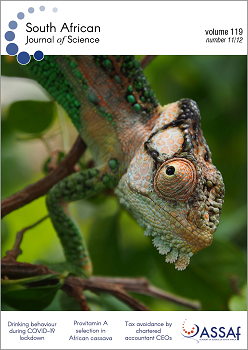SNP-based marker-assisted selection for high provitamin A content in African cassava genetic background
DOI:
https://doi.org/10.17159/sajs.2023/15115Keywords:
vitamin A deficiency, marker-assisted selection, provitamin A content, Kompetitive Allele-Specific PCRAbstract
Vitamin A deficiency (VAD) contributes to significant levels of mortality and morbidity, particularly among children and women in Africa. Cassava is a major staple crop whose biofortification with betacarotene can contribute to reducing the VAD prevalence in a cost-effective and sustainable approach. Developing high provitamin A content (pVAC) cassava varieties through the conventional approach is a laborious and slow process, partly due to the breeding bottlenecks caused by the biology of the crop. To complement the phenotypic screening for pVAC and increase selection efficiency as well as accuracy, we employed four Kompetitive Allele-Specific PCR (KASP) assays to predict the level of carotenoids in a cassava population developed from open-pollinated crosses. There was significant correlation (r= 0.88) between total carotenoid content (TCC) and root tissue colour score in the study population. Marker S1_24155522 at the phytoene synthase gene explained most of the phenotypic variation in TCC and root colour (R2= 0.37 and 0.55, respectively) among the genotypes evaluated in this study. The other markers did not individually account for much phenotypic variation in the trait in our study population. Three genotypes – namely UIC-17-679, UIC-17-1713, and UIC-17-2823 – had higher TCCs, ranging from 10.07 μg/g to 10.88 μg/g, than the national yellow check variety IITA-IBA-TMS070593 (9.20 μg/g). Marker PSY572/S124155522 is therefore recommended for routine use in marker-assisted selection for pVAC enhancement in African cassava germplasm.
Significance:
We evaluated the performance of the SNP markers associated with provitamin A content in a cassava population and draw relevant conclusions that will foster the applications of these markers in different cassava improvement programmes with similar interests. Marker-assisted selection was sufficiently accurate for an early screening of individuals for carotenoid content, especially when thousands of genotypes are usually handled. This screening will reduce efficiently the challenges and burden attached to the use of sophisticated instruments for carotenoid quantification (e.g. HPLC and I-check) for the benefit of breeders and researchers in the field.
Published
Issue
Section
License

All articles are published under a Creative Commons Attribution 4.0 International Licence
Copyright is retained by the authors. Readers are welcome to reproduce, share and adapt the content without permission provided the source is attributed.
Disclaimer: The publisher and editors accept no responsibility for statements made by the authors
How to Cite
- Abstract 435
- PDF 790
- EPUB 146
- XML 368













.png)